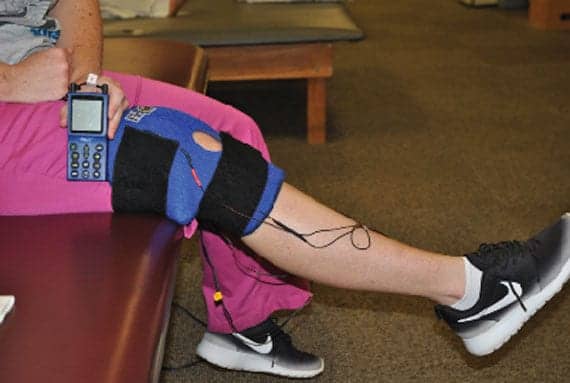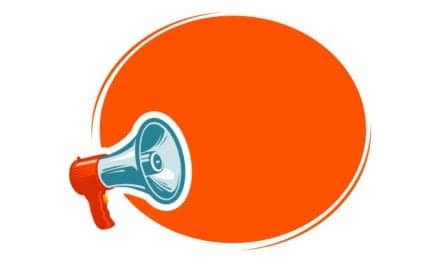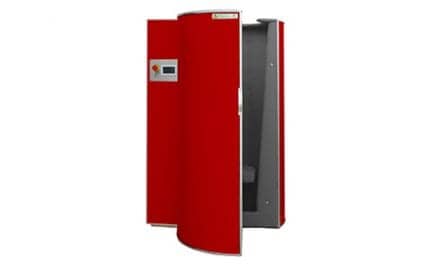Biofeedback can be a key component in muscle retraining, pain treatment, and restoration of motion.
By Vicki Buchanan, PT
The body is designed to move in motions and patterns that rely on the muscles to fire at specific times and specific orders if that motion is to occur correctly. If the muscles fail to fire at the correct time—or at all—the movement pattern will be affected. The resulting poor biomechanical motion can often cause pain in joints around the area where the motion occurs. This pain, in turn, can adversely affect therapeutic exercises that are intended to assist in promoting correct motion. Exercises performed incorrectly are less effective, and thus exercises performed to help reduce pain ultimately are less effective in their ability to help relieve pain.
In contrast, studies show that treatments performed correctly in functional positions produce better outcomes. From a neurodevelopmental perspective, rehabilitation training is mainly done in the brain, and it is because of this that biofeedback tools can help improve awareness of when the body performs with altered movement patterns. Likewise, biofeedback can provide information to the brain that confirms incorrect patterns have been corrected or improved as exercise is performed.
Biofeedback and biofeedback devices can provide effective methods for promoting a restoration of motion. Biofeedback devices are designed to alert the body via other senses, such as vision or auditory signals, that a weak muscle is either contracting or failing to contract. The mechanism is relatively simple, relying primarily on placement of a device that measures muscle contraction over the weak muscle. The patient is asked to perform a simple motion, and the biofeedback device sends feedback to the patient though signals such as lights, pressure sensor readings, or sounds that indicate a muscle is contracting.
Uses of Biofeedback
While the use of biofeedback technology is not new for the treatment of knees and shoulders, or for incontinence training, it has been under-utilized for treatment of conditions involving the spine. Contraction of the spinal musculature is often inhibited by pain, causing the paraspinal muscles to either not fire at all, or fire out of sequence. Recent trends in treatment have been focusing more on whole-body movement rather than regional segmental movement for optimum retraining. Biofeedback can perform a key role in assisting smaller muscles to work properly when retraining with a whole-body motion.
Types of Biofeedback Equipment
Biofeedback equipment can range from simple to complex. The simpler levels of biofeedback equipment are items that measure the force of muscle contraction. One such device is the Stabilizer Pressure Biofeedback cuff from Chattanooga, a DJO Global company, Vista, Calif, which resembles a blood pressure cuff. It can be placed under the knee, lower back, or neck to facilitate the muscle contraction. The pressure gauge displays the amount of pressure the body generates in mmHg. However, it doesn’t specifically isolate a muscle to help evaluate which one is contracting. This type of biofeedback can be helpful when a therapist is unable to elicit any contraction from the body. I have found it specifically helpful when trying to have the patient perform a quad set or posterior pelvic tilt.
DJO’s Chattanooga line has a surface electromyogram (sEMG) setting on the Vectra Genisys machine that utilizes surface electrodes to measure the amount of contraction a muscle can elicit, and plays music once the minimum threshold is achieved. I find patients like the pleasant feedback during the initial phases of treatment when trying to achieve a muscle contraction following surgery.
More complex biofeedback devices use electrodes to measure the amount of output from a specific muscle, such as the Vastus Medialis Obliques (VMO), during a quadriceps contraction to assist in correcting patellar alignment. The VMO has long been shown to not contract at all, or in the proper sequence, which leads to chronic knee pain. A handheld machine, such as the MyoTrac from Canada-based Thought Technology, utilizes a combination of lights and tones to help the patient recognize when the weak muscle is working properly. The size of the device makes it easy to use when the patient is mobile, and therefore assists in global movement pattern retraining. MyoTrac has multiple sensitivity settings that allow weaker or fatigued muscles to be monitored.
Fun types of biofeedback include interactive game systems such as Nintendo’s Wii system. The Wii system has interactive balance boards and remotes that provide on-screen feedback to the user to assist in corrections of movement. Using the Wii system can add a component of fun to retraining activities.
Biofeedback for Common Ailments
Biofeedback equipment for conditions such as headaches and stress relief are machines that measure resting muscle tension or skin temperature. These types of devices use surface electrodes that attach to the skin to make the measurement. They help the patient relax, with the patient turning on/off sounds or lights as they are able to relax the muscles and reduce the tension in the tight muscles.
Spinal Biofeedback
For spinal biofeedback, the Ab-Inforcer Core Biofeedback Trainer, available from Patterson Medical, headquartered in Warrenville, Ill, utilizes lights, sound, and adds a component of vibration as a way to provide more input to the brain about what is happening in the body. This device utilizes the spinal neutral position and incorporates the head position to avoid excessive strain on the neck. Pressure plates located in the lumbar portion of the Ab-Inforcer isolate the left and right paraspinal muscle contractions to help the patient see that one side is not contracting correctly. The head portion has a buzzer that sounds if the patient lifts the head off the plate, indicating that the patient is putting excessive strain on the cervical spine when engaging the core muscles. The patient would never be aware that any compensatory patterns are occurring without the visual and auditory input that are provided. The Ab-Inforcer can be used in supine or standing with the machine placed against a wall, thus moving the patient into a more functional pattern for retraining.
Stimulation for Weak Muscle Training
Once the weak muscles are identified, the retraining tasks can begin. Several stimulation devices are very helpful in retraining the weak muscles and integrating the function to allow correct firing sequences. The sequencing of the muscle contraction can be the link to getting a pain-free movement pattern, so electrical devices that allow specific timing of the contraction are very helpful in the rehabilitation process. EMPI, a DJO Global company, has a 300PV electrotherapy system that utilizes a trigger control to create a muscle contraction at the exact moment the contraction is needed. The symmetrical biphasic waveform is meant to be more comfortable for the patient during the treatment. Setting the device for a zero ramp time and 3-second contraction allows for optimal effectiveness during a functional activity.
Reducing Functional Activity-Related Pain
Pain can be the number one cause of muscle inhibition during an activity. Many electrical devices can assist in reducing pain during a functional activity. EMSI, a medical device company based in Tampa, Fla, offers Flex-Line products that are wearable during activities that will help reduce pain. Combining the electrical stimulation of interferential stimulation with the Flex-Gar garments helps to reduce spasms in the deep tissues of the muscular layers.
There are garments designed to fit the spine, shoulder, arm, hand, knee, and ankle without significantly restricting movement. The garments have the ability to move the electrodes to different places based on pain and muscle inhibition.
Incontinence Training
For incontinence training, MyoTrac has the SEMG probe that allows for retraining in the functional positions of walking, standing, and prone lying. The ability of a device to be used in multiple functional positions is critical to the long-term improvement of the condition.
Biofeedback in the Clinic
Biofeedback can bridge the gap for neural integration of motion to correct biomechanical deficits. Biofeedback comes in many forms, shapes, and sizes, and can enable physical therapists to add a significant amount of fun to the rehabilitative process. PTP
Vicki Buchanan, PT, is founder and owner of Regional Physical Therapy Inc, Midwest City, Oklahoma. She has multiple outpatient clinics and is an active member of the American Physical Therapy Association and the Oklahoma Physical Therapy Association. For more information, contact [email protected].





